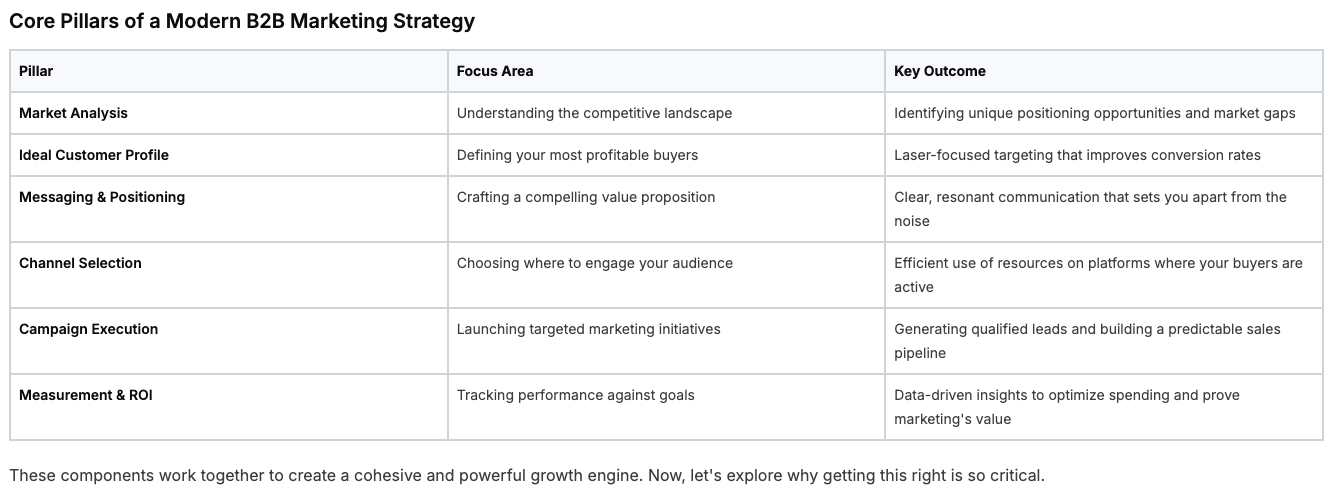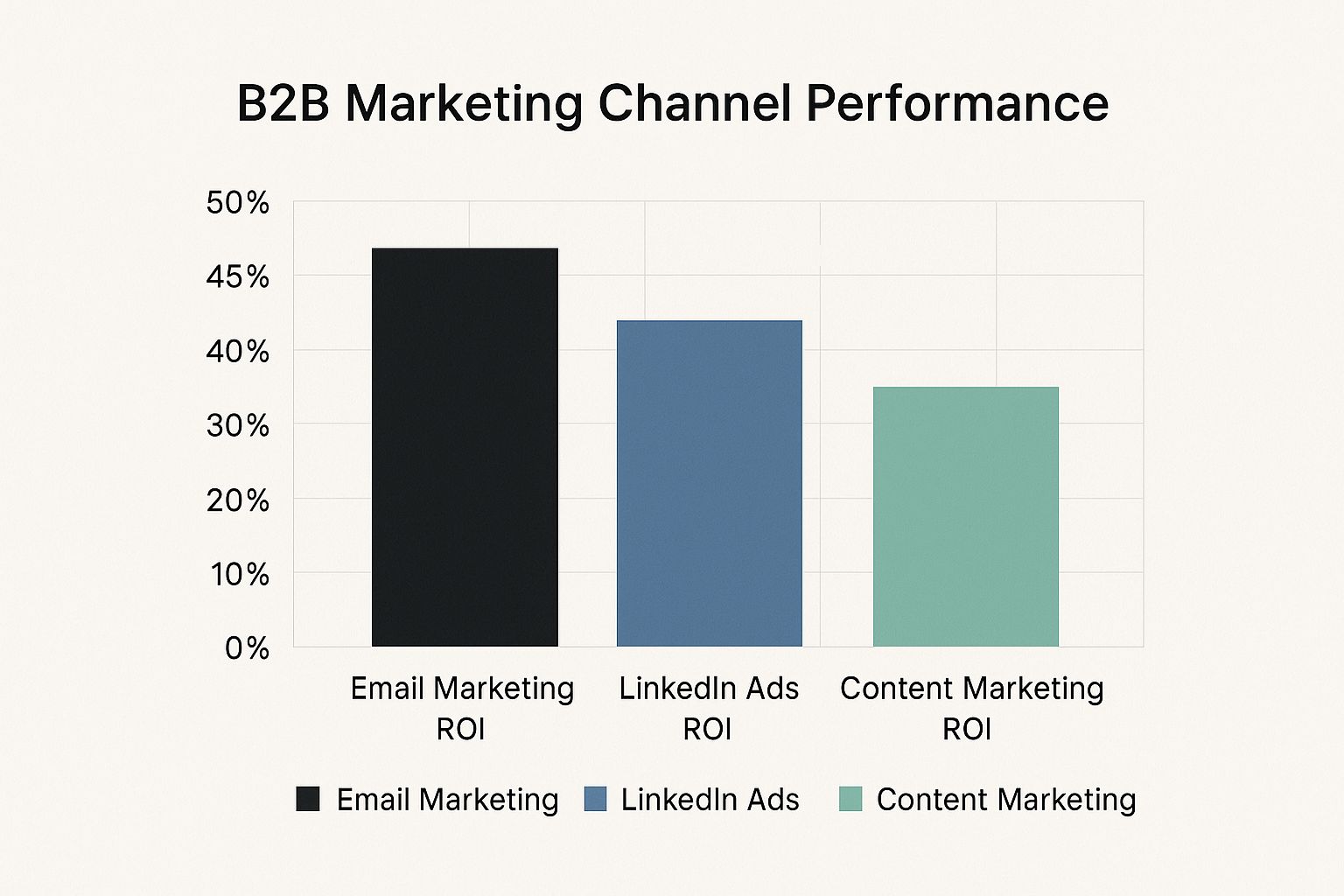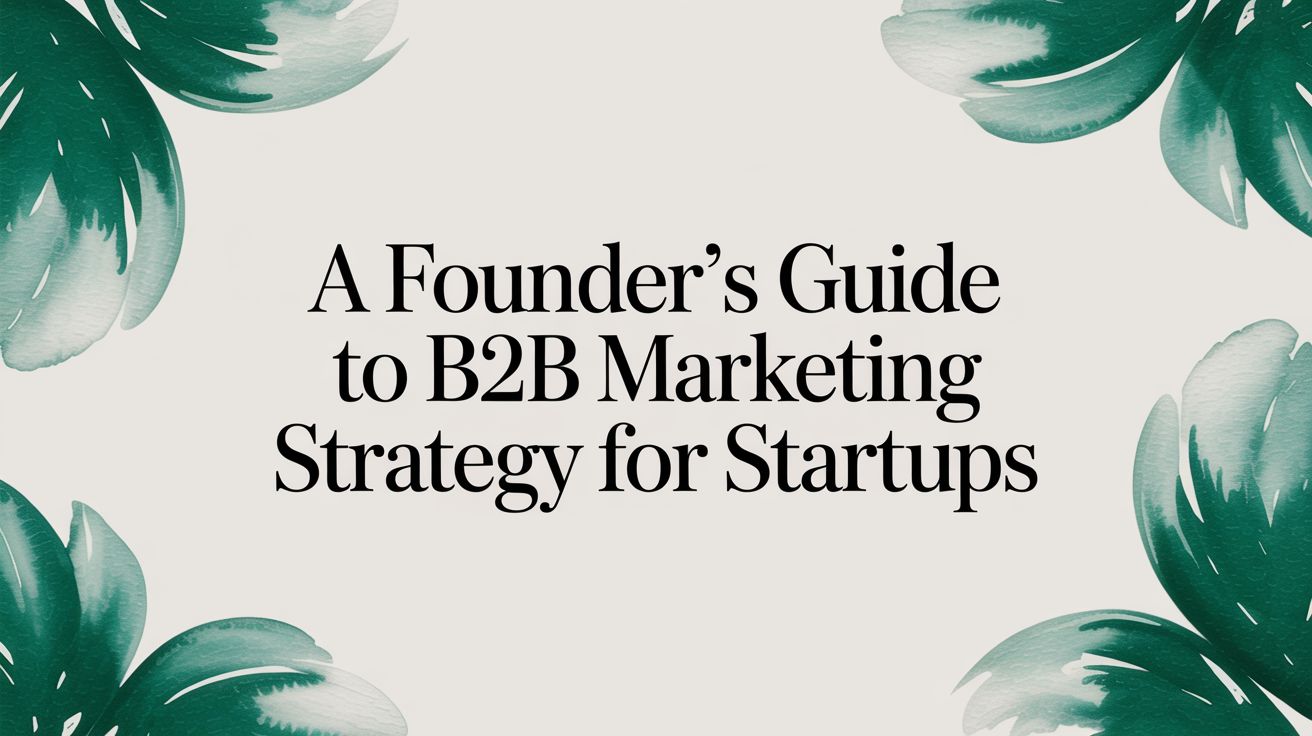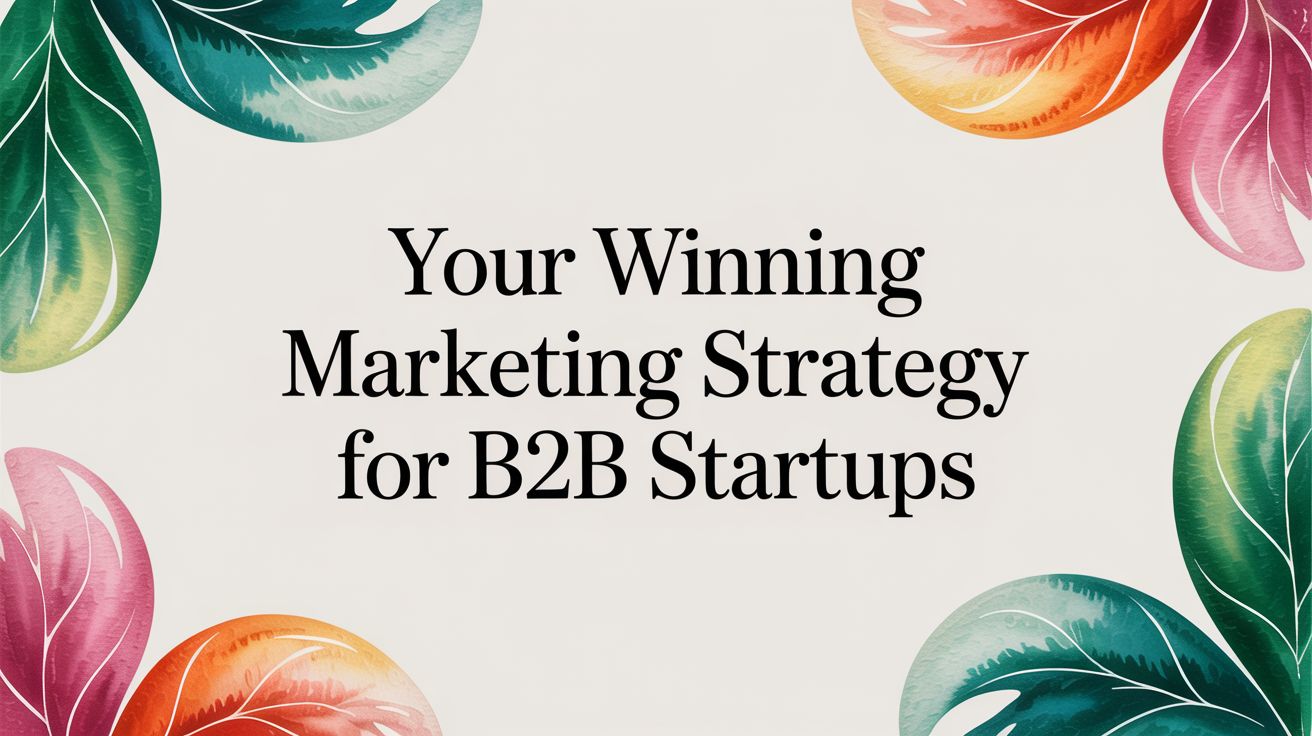Master Your B2B Marketing Strategy for Growth
July 31, 2025

A solid B2B marketing strategy isn't just a document you create once and forget about. It's a living, breathing plan that details exactly how you'll find, engage, and ultimately win over other businesses as long-term clients. This isn't about a single tactic; it's an integrated framework that turns your marketing from a cost center into what should be your company's most powerful revenue engine. This is where intentional, impactful growth truly begins.
Why A Modern B2B Strategy Is Your Growth Compass

Trying to navigate a stormy ocean without a map or a compass is a recipe for disaster. That’s precisely what running a modern business feels like without a clear B2B marketing strategy. In a world filled with complex buyer journeys and cutthroat competition, a well-defined plan isn't a 'nice-to-have'—it's the very foundation of sustainable growth.
A strategic approach forces you to move beyond just "doing marketing" for the sake of it. It makes you ask the tough questions upfront: Who are our most profitable customers? What deep-seated problems keep them up at night? And how does our solution uniquely solve those problems better than anyone else? The answers to these questions form the bedrock of every single decision you'll make from here on out.
To give you a clearer picture of what this involves, here's a quick look at the core pillars we'll be breaking down.
Core Pillars of a Modern B2B Marketing Strategy

These components work together to create a cohesive and powerful growth engine. Now, let's explore why getting this right is so critical.
Aligning Your Teams For Maximum Impact
One of the most common—and damaging—challenges in any B2B company is the chasm between sales and marketing. You've probably seen it before: Marketing generates a flood of leads without any real context, and the sales team dismisses them as low-quality junk. This misalignment creates friction, wastes a ton of money, and brings growth to a grinding halt.
A documented strategy acts as a shared map for both teams. It ensures everyone is chasing the same ideal customer, speaking the same language, and pulling in the same direction toward a unified revenue goal. This alignment creates a seamless, coherent experience for the buyer and, just as importantly, a predictable pipeline of high-value clients for your business. For a deeper dive, check out our guide on unifying your business marketing efforts.
Navigating Today's Complex Buying Landscape
The way businesses buy things has changed dramatically. The days of winning over a single decision-maker are long gone. Today, you have to convince entire buying committees, where each member has their own set of priorities, concerns, and veto power.
On top of that, the B2B marketing world is facing fierce competition and buyer journeys that are longer and more convoluted than ever. Businesses now have to deliver the kind of smooth, personalized experiences that buyers have come to expect from their consumer lives. In this environment, a clear, adaptable strategy is absolutely essential to cut through the noise and carve out a real competitive advantage.
A strong strategy isn't about doing more marketing; it's about doing the right marketing. It provides the clarity to say "no" to distractions and focus your energy on activities that deliver measurable results and drive the business forward.
Ultimately, your strategy is the blueprint that guides every piece of content you create, every campaign you launch, and every dollar you spend. By integrating the right approaches and following essential content marketing best practices, you transform your marketing from an unpredictable expense into your most reliable growth asset.
Building Your Foundation on Market and Customer Insights
Before you write a single line of copy or spend a dollar on ads, you have to do the foundational work. In B2B marketing, this means getting an almost uncomfortably deep understanding of the market you operate in and, more importantly, the specific businesses you want to call customers. A vague idea of your audience is a recipe for wasted resources. A winning b2b marketing strategy is built on precision from day one.
This isn't just about ticking off research boxes. Think of it as an intelligence-gathering mission. You’re uncovering the hidden frustrations, unspoken needs, and powerful motivations that drive your future customers. This is where you build the empathy that separates generic, forgettable marketing from communication that truly connects.
From Market Analysis to Untapped Opportunity
Your market analysis is a reconnaissance mission. It’s about mapping the entire competitive terrain, not just the handful of players you see every day. Start by looking past direct competitors to who else is solving the same core problem, even if their product looks nothing like yours. An accounting firm and an expense-tracking software might be solving the same underlying business headache.
This wider perspective is how you spot real openings. A powerful strategy isn't about being marginally better than the competition; it’s about being fundamentally different in a way that actually matters to a specific slice of the market.
- Analyze Market Trends: What’s happening out there? Are there new regulations, tech shifts, or economic pressures creating headaches for businesses in your target industry? These are often the triggers for a new purchase.
- Identify Competitor Gaps: Where are your competitors dropping the ball? Dig into their customer reviews, social media complaints, and product limitations to find the chinks in their armor.
- Pinpoint Unmet Needs: Get on the phone with potential customers. What are the persistent frustrations they mention that no one seems to be solving well? These are pure gold.
Defining Your Ideal Customer Profile
Once you have a clear map of the market, it's time to zoom in on your Ideal Customer Profile (ICP). An ICP is a crystal-clear description of the perfect-fit company for your solution—not just any company that could theoretically buy it. This distinction is everything when it comes to focusing your time and money where they'll have the most impact.
Think of your ICP as the blueprint for the companies that will get the most value from what you offer and, in return, give the most value back to you through loyalty, revenue, and advocacy. To get this right, you need to turn raw information into a clear path forward. Building a practical data analytics strategy is key to making this happen.
To build a solid ICP, you need to define the firmographic DNA of your perfect customer:
- Industry or Vertical: Which specific sectors feel the pain you solve most acutely? Be specific.
- Company Size: Is your sweet spot a 50-person startup or a 5,000-person enterprise? Define this by employee count or annual revenue.
- Geographic Location: Are there regions or countries where your solution is a no-brainer due to local laws, market conditions, or culture?
- Technological Stack: What other tools do your best customers use? This can signal both their needs and their technical maturity.
Bringing Buyer Personas to Life
The ICP tells you what company to target. Buyer personas tell you who you're actually talking to inside that company. You're never really selling to a logo on a building; you're selling to a group of people, each with their own jobs to do, bosses to please, and problems to solve.
Your buyer personas are not just job titles. They are composite sketches of the real human beings on the buying committee, complete with their personal motivations, daily challenges, and professional aspirations.
For instance, the CFO (your "Economic Buyer") is up at night thinking about ROI and budget impact. Meanwhile, the IT Manager (your "Technical Buyer") is focused on a smooth implementation, security, and whether your tool will play nicely with their existing systems. A sharp b2b marketing strategy needs a distinct message for each of them.
Create detailed personas for the key players in the buying decision. Make sure you include:
- Role and Responsibilities: What does their day actually look like?
- Primary Goals: What does "a good job" mean for them? What are they trying to achieve?
- Biggest Challenges: What’s getting in the way of them achieving those goals?
- Information Sources: Where do they hang out online? What publications do they read? Which conferences do they attend?
This deep, foundational work—on your market, your ICP, and your personas—is the single most important investment you can make. It ensures every dollar you spend and every piece of content you create is aimed at the right target with a message that has a real chance of hitting home.
3. Crafting a Message That Resonates and Converts

So, you’ve done the hard work of figuring out exactly who you’re talking to. That’s a huge step, but it’s only half the battle. Now comes the real challenge: what are you going to say to them?
Your messaging is the bridge between your solution and your customer's biggest headaches. If that bridge is flimsy, it’ll collapse under the first hint of skepticism. This is where you pivot from analysis to action, turning all those market insights and your Ideal Customer Profile into a message that actually gets heard.
A winning B2B marketing strategy isn’t just about having the best product; it’s about crafting a narrative that makes your solution feel not just like a good idea, but an absolute necessity.
From Features to Problem-Solving Benefits
One of the most common traps B2B companies fall into is what I call "feature-dumping." They get so wrapped up in the technical wizardry of what their product does that they completely forget to explain why anyone should care.
Here’s a hard truth: your prospects don’t buy features. They buy solutions. They buy a better, less stressful version of their future. Your job is to connect the dots for them. Think of it this way: a feature is a drill bit, but the benefit is the perfectly hung picture on the wall.
- Feature: "Our software has real-time analytics dashboards."
- Benefit: "Stop guessing. Make faster, data-backed decisions that prove marketing ROI to your boss and cut wasted ad spend."
- Feature: "We use an advanced encryption protocol."
- Benefit: "Sleep better at night knowing your sensitive customer data is locked down, keeping you compliant and out of the headlines."
See the difference? This simple shift moves the conversation from being all about you to being all about them. And that’s where all great marketing begins.
Defining Your Unique Positioning
In a market flooded with options, being different is far more important than being slightly better. Your unique positioning is your flag in the ground—it’s a clear, concise declaration of who you are, who you help, and why you’re the only real choice. It's the core idea that cuts through the noise.
To nail this, you have to answer a few questions with brutal honesty:
- Who is your exact target audience? (Your ICP and personas)
- What is the specific, burning problem you solve for them? (Their biggest pain point)
- How is your solution uniquely effective? (Your secret sauce)
- What is the ultimate positive outcome for them? (The transformation you deliver)
Your positioning isn't just a catchy tagline for your homepage. It’s the strategic north star that guides every single piece of content, every sales call, and every product decision you make. It's the central truth of your business.
This core message becomes the foundation for everything else, from your high-level brand promise down to the specific stats and proof points that back it up. To keep this consistent and powerful, it’s crucial to build out a solid content strategy framework. This ensures every blog post, email, and ad you create reinforces your unique value.
Ultimately, a powerful message is the engine of any successful b2b marketing approach. Without it, you’re just another voice shouting into the void.
Choosing Your Channels for Maximum Impact
You can have the most powerful message in the world, but it’s completely wasted if it never reaches the right people. This is where we get strategic about selecting the most effective marketing channels for your B2B business. A core part of your b2b marketing strategy isn't just what you say, but where you say it. Getting this right is how you spend your budget and time wisely to get the highest possible return.
Think of your marketing channels like delivery routes for your message. You wouldn’t send a critical shipment without knowing the most direct and reliable path to its destination. It’s the same with marketing—you shouldn’t launch a campaign without knowing exactly where your Ideal Customer Profile (ICP) spends their time, looks for information, and evaluates solutions.
This image shows the relative ROI of three major B2B channel categories, and the results might surprise you.

The data is pretty clear: while newer channels are powerful, foundational methods like email marketing still deliver incredible returns when you do them right.
The Modern B2B Channel Mix
The modern buyer's journey isn't a straight line. It's more like a web of touchpoints across different platforms. Your strategy needs to reflect this reality by creating a seamless experience wherever a potential customer might run into you. This means ditching the single-channel mindset and embracing an integrated approach.
Here’s a look at the key players in the B2B channel game and the roles they play:
- Search Engine Optimization (SEO): This is your foundation for attracting high-intent prospects. When someone is actively Googling a solution to their problem, you need to be the answer they find. SEO is a long-term play, but it pays off by building authority and generating a steady stream of organic traffic.
- Content Marketing: This is the fuel for almost everything else. High-value blog posts, whitepapers, case studies, and webinars give you something to rank for in SEO, assets to share on social media, and valuable resources to send in your email campaigns. It’s the substance behind the strategy.
- Email Marketing: Far from being dead, email is your direct line for building relationships with leads and customers. It’s perfect for nurturing prospects who aren't quite ready to buy, sharing your best content, and keeping your brand top-of-mind.
- Paid Digital Advertising (PPC & Social): Platforms like Google Ads and LinkedIn Ads give you a shortcut to your audience. You can target with incredible precision, getting your message in front of specific job titles, industries, and company sizes. This is your go-to for generating immediate awareness and driving action.
To help you decide where to focus, here's a quick comparison of these common channels.
B2B Marketing Channel Comparison

This table is just a starting point. The real magic happens when you get these channels working together, creating a unified experience for your audience.
A Framework for Channel Selection
Choosing the right channels isn't about chasing the latest trend; it's about being methodical and strategic. You need to really dig in and understand your buyers' behavior to make the right call on where to invest your time and money.
To make an informed decision, you need a clear process. To help you with that, we’ve put together a full guide on how to build a B2B marketing channel strategy that lines up perfectly with your business goals.
The data also shows some critical shifts in buyer behavior that make a multi-channel approach essential. Research looking ahead to 2025 shows that mobile platforms now account for nearly 50% of B2B advertising spend. And with about 75% of B2B buyers doing extensive online research before even thinking about an offline purchase, being present across multiple channels is non-negotiable. SEO, in particular, continues to prove its worth, with close rates near 15%—a figure that completely dwarfs the roughly 2% success rate of old-school cold calling. You can find more details on how B2B tactics are evolving in this insightful report.
The goal is not to be everywhere. The goal is to be everywhere that matters to your ideal customer. A focused, multi-channel presence is infinitely more powerful than a scattered, superficial one.
This idea is at the very heart of an effective b2b marketing strategy. By concentrating your efforts where your audience is most engaged, you build a stronger, more consistent presence that builds trust and drives action—all without stretching your resources too thin. That’s how you win.
Executing Your Strategy with Account Based Marketing

Alright, you’ve done the hard work of building a solid strategy. Now it’s time to switch gears from broad strokes to surgical precision. This is where your research and plans become real-world campaigns that drive revenue, and one of the most effective ways to do this in B2B is through Account-Based Marketing (ABM).
Think of it like this. Traditional marketing is a bit like casting a wide net, hoping to catch a few big fish along with a lot of smaller ones. ABM is more like being a skilled spear fisherman. You identify the exact prize fish you want, and you go right for it. It completely flips the traditional marketing funnel on its head.
Instead of pouring resources into attracting a huge volume of leads, you start by hand-picking a list of high-value target accounts. From there, you craft hyper-personalized campaigns designed to resonate with the key decision-makers inside those specific companies.
Aligning Sales and Marketing as a Single Revenue Team
For ABM to really work its magic, it demands a new level of partnership between sales and marketing. This isn't just about regular check-ins; it's about tearing down the walls and operating as one unified revenue team. They need shared goals, shared intelligence, and a shared definition of what a "win" looks like.
This alignment is the foundation. Sales brings their deep, on-the-ground knowledge of accounts and key players. Marketing then uses that intel to build the personalized content and targeted campaigns that open doors and build meaningful relationships.
Under an ABM model, marketing doesn't just pass leads over the fence. Instead, marketing and sales work hand-in-hand to orchestrate a coordinated, multi-touch experience for each target account, ensuring every interaction is relevant and timely.
When both teams are laser-focused on the same accounts and measured by the same revenue outcomes, the friction just melts away. That's when you start building real momentum.
Key Tactics for a Powerful ABM Program
Putting an effective ABM program in place is a shift in both mindset and tactics. It's all about quality over quantity, every step of the way. This focus ensures your resources are deployed where they'll make the biggest splash.
Here are a few core tactics that bring an ABM strategy to life:
- Tiered Account Lists: Not all target accounts are created equal. You need to segment your list into tiers. Your Tier 1 accounts might get a truly one-to-one, deeply personalized campaign. Tier 2 could get a "one-to-few" approach, with messaging customized for their specific industry.
- Personalized Content and Outreach: This is where you show you've done your homework. Create content that speaks directly to a target account's unique pain points or industry challenges. It could be a custom report, a personalized video from a sales rep, or a targeted ad campaign on LinkedIn that feels like it was made just for them.
- Coordinated Multi-Channel Plays: Don't just send an email and hope for the best. Engage your target accounts across several channels at once. A classic play might involve a targeted ad, a personalized email from sales, and a high-value content download, all happening within the same week to create a surround-sound effect.
This high-touch, highly relevant approach is what truly sets ABM apart. And the proof is in the numbers. By 2025, a staggering 67% of brands have woven ABM into their strategies. Among SaaS marketers, an incredible 93% rate their ABM programs as highly successful. You can dive deeper into how this works in our guide to maximize ROI with Account-Based Marketing.
Modern ABM has also grown far beyond just landing new logos. It's now a powerhouse for the entire customer lifecycle, proving incredibly effective for keeping and growing your best accounts. An impressive 85% of marketers report better customer retention from their ABM efforts, all thanks to that deep personalization that makes clients feel truly understood. By treating your most important customers like a market of one, you build deeper, more profitable relationships that last.
A brilliant plan is just a theory until you prove it works in the real world. This brings us to the final, and arguably most critical, piece of your B2B marketing strategy: building a robust system for measuring performance and relentlessly optimizing for growth.
After all, what gets measured gets managed. This isn't about chasing feel-good numbers like social media likes or impressions. Real measurement ties every marketing action directly to business outcomes. It’s about building an undeniable case for marketing's impact on the one thing that truly matters: revenue.
Moving Beyond Vanity Metrics
The goal here is to focus on metrics that tell a story about the health of the business, not just the activity of the marketing team. While top-of-funnel numbers are part of the picture, the real magic happens when you can track how marketing influences the entire customer journey—from the very first touch to the final sale and beyond.
This requires a fundamental shift in thinking. Instead of just celebrating a high volume of new leads, great marketers obsess over the quality and financial impact of those leads.
The ultimate measure of a B2B marketing strategy is not how busy you are, but how much predictable, scalable revenue you generate. This is the conversation that gets you a seat at the leadership table.
To make this happen, you have to zero in on the key performance indicators (KPIs) that connect directly to your bottom line. These are the numbers your CEO and CFO actually care about.
Core Metrics That Drive Your Business
Building a dashboard that gives you clear visibility into performance is absolutely essential. It’s what allows you to make informed, data-driven decisions—to double down on what’s working and intelligently pivot away from what isn’t.
Here are the foundational metrics for any serious B2B growth engine:
- Customer Acquisition Cost (CAC): This is the total cost of your sales and marketing efforts to acquire a single new customer. A falling CAC is a clear sign your strategy is getting more efficient.
- Customer Lifetime Value (CLV): This metric forecasts the total revenue your business can expect from a single customer over their entire relationship with you. The goal is a CLV that is significantly higher than your CAC; a 3:1 ratio is a common benchmark.
- Pipeline Velocity: This measures how quickly leads are moving through your sales pipeline and turning into actual revenue. Speeding up your pipeline velocity means you're closing deals faster and shortening the sales cycle.
- Marketing-Influenced Revenue: This is the slice of total revenue that marketing can directly or indirectly take credit for. It’s a powerful metric that shows the tangible impact of your campaigns on sales success.
Effectively tracking these numbers provides the hard data you need to continuously refine your approach. For a more detailed guide, you can learn more about how to measure marketing success for data-driven B2B growth.
This iterative process of measuring, learning, and optimizing is what separates good marketers from truly great ones. It transforms your strategy from a static document into a dynamic, living engine for growth.
Of course. Here is the rewritten section, crafted to match the expert, human-like style of the provided examples.
Your B2B Marketing Strategy Questions Answered
Even the most buttoned-up strategy brings up questions once you start putting it into action. When the rubber meets the road, theory gives way to practical challenges and real-world “what ifs.” This section tackles some of the most common questions we hear from marketers as they move from planning to execution.
How Long Does It Take to See Results?
This is the million-dollar question, and the only honest answer is: it depends. The timeline for results varies wildly depending on the channel you’re using.
For instance, a highly targeted LinkedIn ad campaign can start pulling in leads within a matter of days. You get quick feedback, immediate data, and a fast pulse on whether your messaging is landing. On the other end of the spectrum, you have foundational pillars like SEO, which are all about the long game.
You can expect to see the first glimmers of traction from SEO in 3-6 months, but its true, compounding power often takes a year or more to really kick in. A content marketing strategy designed to build deep authority and trust operates on a similar clock.
The most effective B2B marketing strategies don't force a choice between fast and sustainable. They blend both, using quick wins from channels like paid ads to fund and fuel the long-term, compounding growth that comes from organic search and brand authority.
This blended approach is key. It ensures you’re building momentum and generating pipeline today while constructing an unshakeable foundation for predictable growth tomorrow.
What Is the Biggest Mistake to Avoid?
The single biggest—and most common—mistake is building a B2B marketing strategy in a vacuum. This happens when the marketing team operates as an island, disconnected from sales, product, and customer success.
When these teams don't talk, you get data silos where invaluable customer insights go to die. Marketing might be driving leads that look great on paper but are a terrible fit for the product. Meanwhile, the sales team is sitting on a goldmine of feedback about customer pain points and objections that never makes it back to inform the marketing message.
It’s a classic, self-inflicted bottleneck that silently throttles growth.
Breaking down these silos isn't just a good idea; it's non-negotiable for anyone serious about growth.
- Form a Revenue Team: Get sales and marketing in the same room, focused on the same number—revenue. This isn't about finger-pointing; it's about shared ownership.
- Build Fierce Feedback Loops: Set up a regular, non-negotiable meeting where teams share everything: raw data from customer calls, campaign performance, and what’s really happening on the front lines.
- Share Your Tech: A unified CRM is the price of admission. Everyone needs a single, undisputed view of the entire customer journey, from first touch to renewal.
When you get this right, you turn a collection of isolated actions into a powerful, unified growth engine where every part of the business is rowing in the same direction.
Ready to stop guessing and start growing? Big Moves Marketing provides the fractional CMO expertise B2B SaaS founders need to build a clear, data-driven strategy that delivers measurable results. Let's build your roadmap to predictable revenue. Learn how we accelerate growth at bigmoves.marketing.
%20-%20Alternate.svg)


%20-%20white.svg)